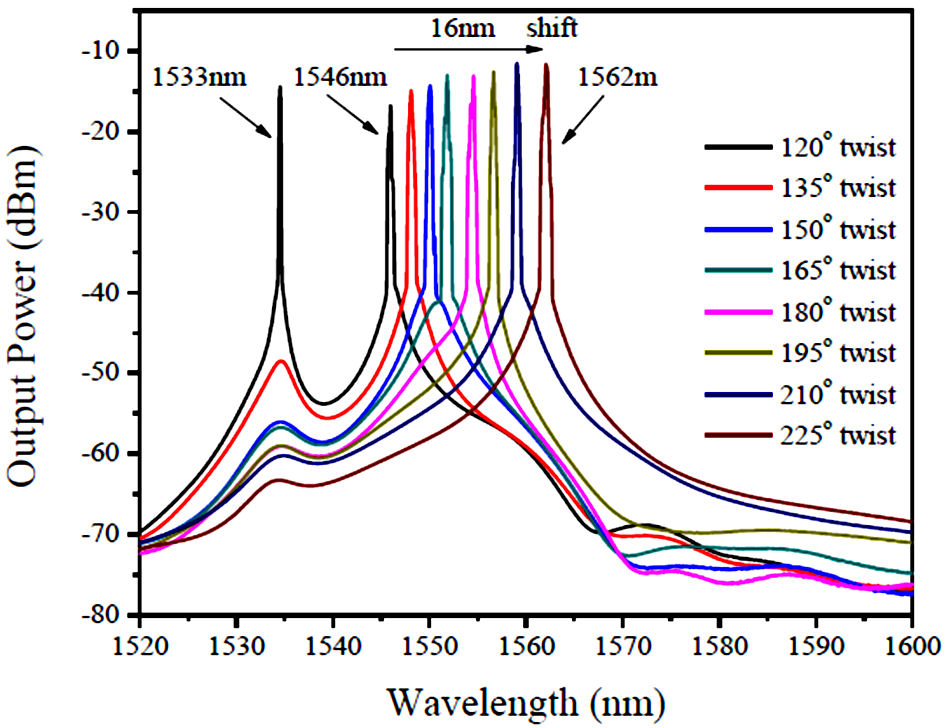1. Introduction
Continuous and pulsed wave linear fiber laser cavities have been attractive for researchers during long period of time [1-3], owing to its several advantages such as: compactness, minimal operation elements and stability. Moreover numerous works deals to improve tunability or switch issues, as a result several arrangements based on Fabry-Perot filters [4-12], Mach-Zehnder interferometer [13-16], losses effect in gain medium [17], mechanical long period grating (MLPG) [18-20], Sagnac interferometers [21-23] and fiber Bragg grating (FBG) [24,25] have been reported. One of the most attracted fiber filter used in fiber laser arrangements are MLPG’s, indeed its wide tunable range by twist effect have been widely demonstrated [26,27], moreover this device offers simple design and low cost implementation as well as multiple sensor applications such as: temperature, refractive index and strain. It is important to point out that several long period gratings, fabricated by different techniques have been proposed as a fiber laser filter devices [28-30]. However, the period and length of these long period gratings can not be adjusted; as a result, physical change like curvature, twist, refractive index environment change or temperature must to be applied over a fragile structure in order to excite tuned or switched effect. In the presented experimental analysis, an adjustable MLPG was set into the linear fiber laser cavity acting as a fiber filter device. Here, a short length of conventional single mode fiber was twisted before to set into the MLPG, as a consequence the tuned and switched effect can be controlled; due to the gain-losses profile is modified into the laser cavity.
In Fig. 1 the schematic configuration of the switchable and tunable linear fiber laser cavity is presented. This fiber laser arrangement is based on four main elements: two loop reflectors based on an optical fiber circulator, a gain medium, provided by 3.5 m of Erbium-Doped Fiber LIEKKITM Er16-8/125 (EDF) and an all fiber MLPG as a cavity loses device which allow us to tuned and switch the fiber laser. Using a 980/1550 nm optical fiber wavelength division multiplexer (WDM), the laser diode (QFBGLD-980-200) with a centered wavelength operation at 980 nm and maximal pump power of 200mW was coupled to the cavity. This laser pump is directed to the EDF, as a result, amplified spontaneous emission (ASE) is generated and guided to the MLPG, (the principle operation will be detailed below) in this point the cavity loses are modified. The light continues to optical fiber coupler (90/10) which allows us to monitoring the laser output by the 10% coupler port connected to the Optical Spectrum Analyzer (OSA) Yokogawa, AQ6370B. The rest of the light (90%) continues to the first optical fiber loop reflector, which reflect the light to second optical fiber reflector set at the 1550nm WDM port, as a consequence ASE oscillation is generated into the cavity and single line emission is obtained in the laser output. In order to have gain and loses equilibrium a polarization controller (PC) was set between EDF and the MLPG.
2. Results and Discussion
The linear fiber laser proposed is tuned by an all fiber mechanical long period grating. Here, a small length of conventional single mode fiber (SMF28) was fixed between two metallic plates, one is totally flat and another one is v-grooved (see Fig. 1 inset), with a period of 620 μm and a length around 55 mm. Using the screws showed in Fig. 1 inset, lateral force is applied over the flat plate, this force can be estimated using a digital torque meter and the relations between torque and force described by [31]. The lateral force applied over the MLPG generated an interaction between fundamental core mode and the high order cladding modes, as a consequence, attenuation band centered at specific wavelength is obtained. The phase matching condition is satisfied by:
where
The linear laser experimental analysis was carryout at room temperature using 130 mW
of pump laser diode power. The linear laser cavity generates a single line emission
centered at 1562 nm (
As was mentioned above the MLPG was operated with a constant lateral force around 22
lb in both screws; in order to obtain tunable effect, the conventional SMF28 length
set into the MLPG was twisted each 15 ∘ from 0 ∘ to 90 ∘ and the output was
recording. As can be observed in Fig. 4, lasing
emission
When the fiber is twisted circular birefringence is induced in the SMF28 [32], as a result, the excitation of high order cladding modes in the MLPG is promoted and wavelength-dependence losses is generated, which modifies the gain-loss medium profile into the linear laser cavity. As the twist increase the losses and high order mode energy also increase. Nevertheless, when the twist is around 120∘ the birefringence generated a significant high order mode energy which provide the laser line centered at 1533 nm, and the MLGP promotes the peak centered at 1546 nm, obtaining dual laser emission as can be observed in Fig. 5. As the twist is modified around 102∘ lasing modal competition can be expected between the dual laser emissions, as a consequence switchable effect is obtained between the lasing modes. Besides, when the twist is increase from 120∘, redshift can be appreciated in Fig. 5.
3. Summary
In conclusion, stable and compact linear fiber laser cavity was experimentally demonstrated. Using a mechanical long period grating (MLPG) with 55 mm length and V-grooved period around 620 μm set into the linear laser cavity, a single line emission centered at 1562 nm can be tuned to 1546 nm, by applying constant lateral force (22 lb) and by twisting conventional single mode fiber each 15∘ from 0∘ to 120∘. Besides, when 120∘ twist is applied dual laser emission is obtained, when the twist is incremented switchable and redshift effect were observed between these lasing modes. The laser offers a tuned range of 16 nm for single emission and it gets double wavelength and switchable for 120 degrees of twist.











 nova página do texto(beta)
nova página do texto(beta)







